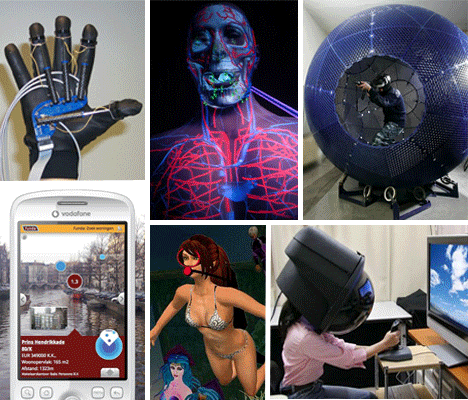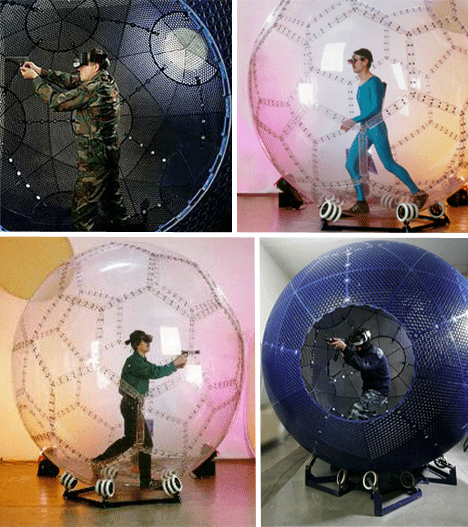

(Images via reversedreality, gazette.unc, edibleapple, technabob, smallbizaffinity)
Augmented reality is the baby brother of virtual reality, as it takes a half step in the right direction by combining the virtual world with the real one. Typically, augmented reality involves wearing a head set or using a mobile device that registers one’s location via GPS and visually matches landmarks to provide information. You may look at the Roman coliseum and see facts appear about gladiators, or see the names of all the restaurants on the street. This is the most immediately practical version of virtual reality, and a real step in the integration between man and machine.
(Images via wholesalelandparts, iowa, artslibrary, dbforums)
Visualizing data with technology has advanced an incredible amount in the last few decades. We no longer have to stare at grainy computer screens or hand drawn graphs. With the advancement of computer processing power has come the ability to visualize data in three dimensions. Whether it’s filling a giant screen with blazing graphs and three dimensional models, or a fully virtual experience that requires a headset, we’ve taken large steps towards making the fiction in television and film, a reality.
(Images via slashgear, gadgettastic, karennutton, newscientist)
Virtual reality chairs used to be a gamer’s dream, only a step below full fledged virtual reality. Sitting in a chair with two joysticks and a screen is a far cry from the 360 degree virtual environment we hope for, but it’s leagues better than the black and white pong of only a few decades ago.
(Images via escience, dailygalaxy, itclimasd)
Ever since the cult classic film The Wizard, which featured the premier of the Nintendo glove (a flop), an entire generation has felt the desire to own a glove that allows one to manipulate objects on a screen. Current technology is now advanced enough to allow tactile feedback in addition to allowing the manipulation of virtual objects. I’m sure a lot of readers are thinking “wake me up when they have a full suit that does this” but be patient! We’re getting there.
(Images via destructoid, dental.upenn, fredazar, medoto)
Virtual reality is a reality in many hospitals, just not in the way we typically imagine. Medical students are able to run simulations on virtual patients that are physically present in the form of a human-shaped doll (though the word “doll” doesn’t give these incredibly advanced, and expensive, tools much credit). Medical students are even able to practice procedures through physical and on-screen manipulations.
(Images via devorak.org, gearmoda, noobcake, warwick)
The virtual reality headset is typically what pops into mind when we think of virtual reality. Giant, clunky, and claustrophobic, the helmet tackles several of our senses at once by fully surrounding our head with a virtual display. Current headsets are able to produce sights, sounds, and smells. The ridiculously giant headset is slowly working its way down to a sleeker, more mobile style, but there’s still a long way to go.
(Images via neatorama, internet3d, huehueteoti, explainthatstuff)
Any fan of Star Trek is familiar with the holodeck, a room devoted to creating virtual environments that seem as real as anything in daily life. The virtual reality room is not quite to that level of sophistication, but they do allow one to be fully immersed in a simulation. Whether the room is for training purposes (such as a flight simulator), or as a tool to display data, they’re the closest we’ve come to our television counterparts.
(Images via virtualreality, doolwind)
Mobility in virtual worlds was a difficulty originally solved by simply not letting one move. You would either coast in-game, or use leaning to control direction. As silly and outdated as this appears today, we’ve come up with an arguably more silly looking solution that’s a thousand times more effective:
(Images via nushakor, impactlab, nanoflix, technovelgy)
Mobility has always been an issue when trying to make virtual reality functional. Unless all virtual reality takes place on an empty football field, someone with a giant helmet on their head is bound to crash into walls. Enter the sphere: Basically a giant hamster ball that allows one to feel movement while remaining stationary. This could very well be a fixture in your grandchildren’s living room one day.
(Images via foxnews, localstranger, washington, geekiegadgets)
Virtual reality is already being used to great effect in several therapeutic and rehabilitative ways. Soldiers are calmed after their return from war by showing them war-like scenes in a safe environment. People with phobias are able to confront their fears with the safety net of not having to physically approach the situation that scares them. People are even able to train on new wheelchairs before they’ve sat in one, or tackle complicated body issues after an amputation.
(Images via masternewmedia, io9, usm, camillamediasecondlife)
Some people are already experiencing the freedom and creativity of the virtual life through games like Second Life, which allow one to design and use an avatar in a virtual world to move about and express oneself. Free of the constraints of their normal lives, these people are able to let loose in an anonymous environment. Not everyone uses this new tool simply for entertainment, however, as many businesses use it to hold virtual events, and some schools even conduct academic lectures that can be attended from anywhere in the world. Right now this is all conducted via a computer screen, but at the current rate, it won’t be long before we’re able to experience virtual worlds in a full 360 degree environment.You have read this article with the title Virtual Reality: Futuristic Tools for Virtual Worlds. You can bookmark this page URL http://tiffanyeatworld.blogspot.com/2011/12/virtual-reality-futuristic-tools-for.html. Thanks!










